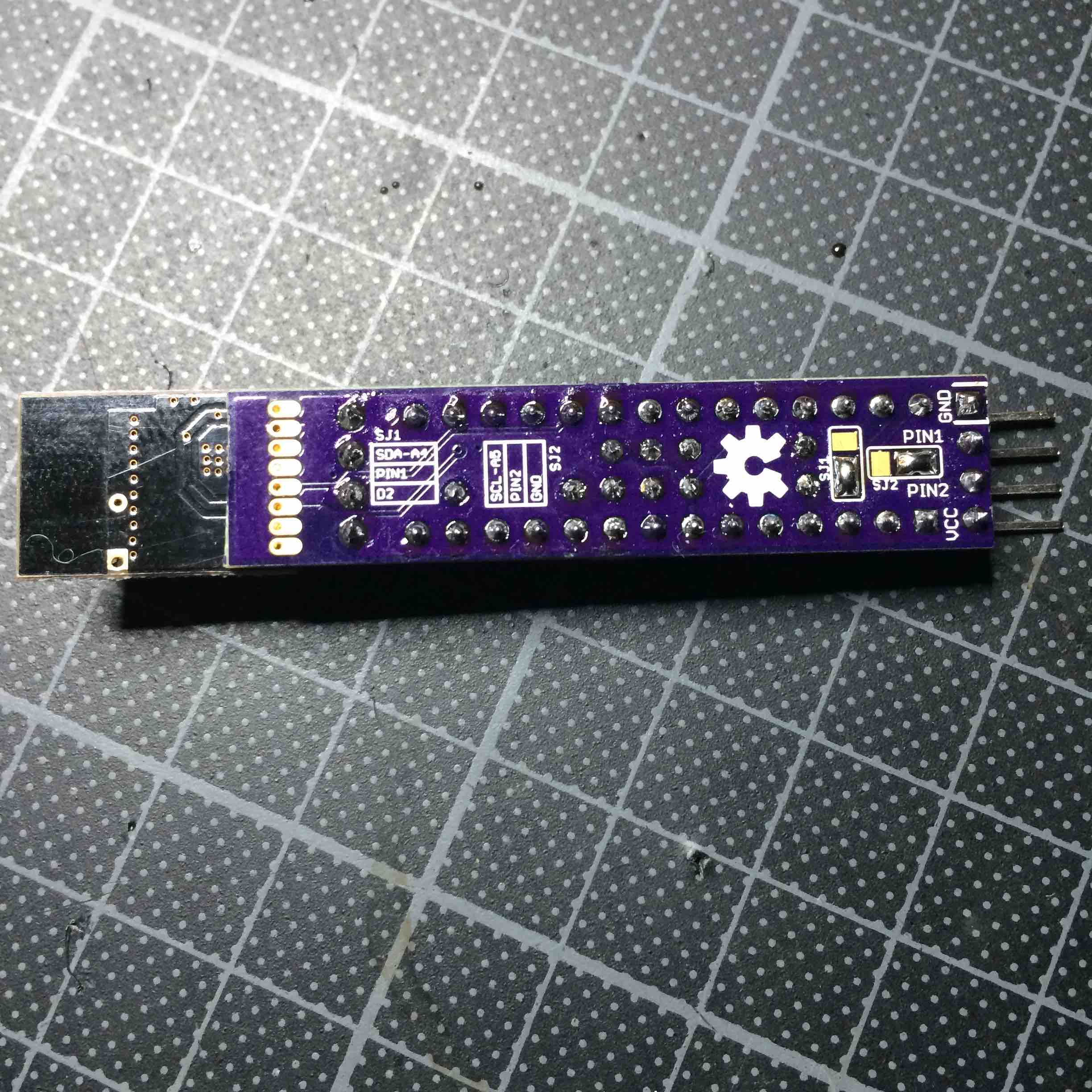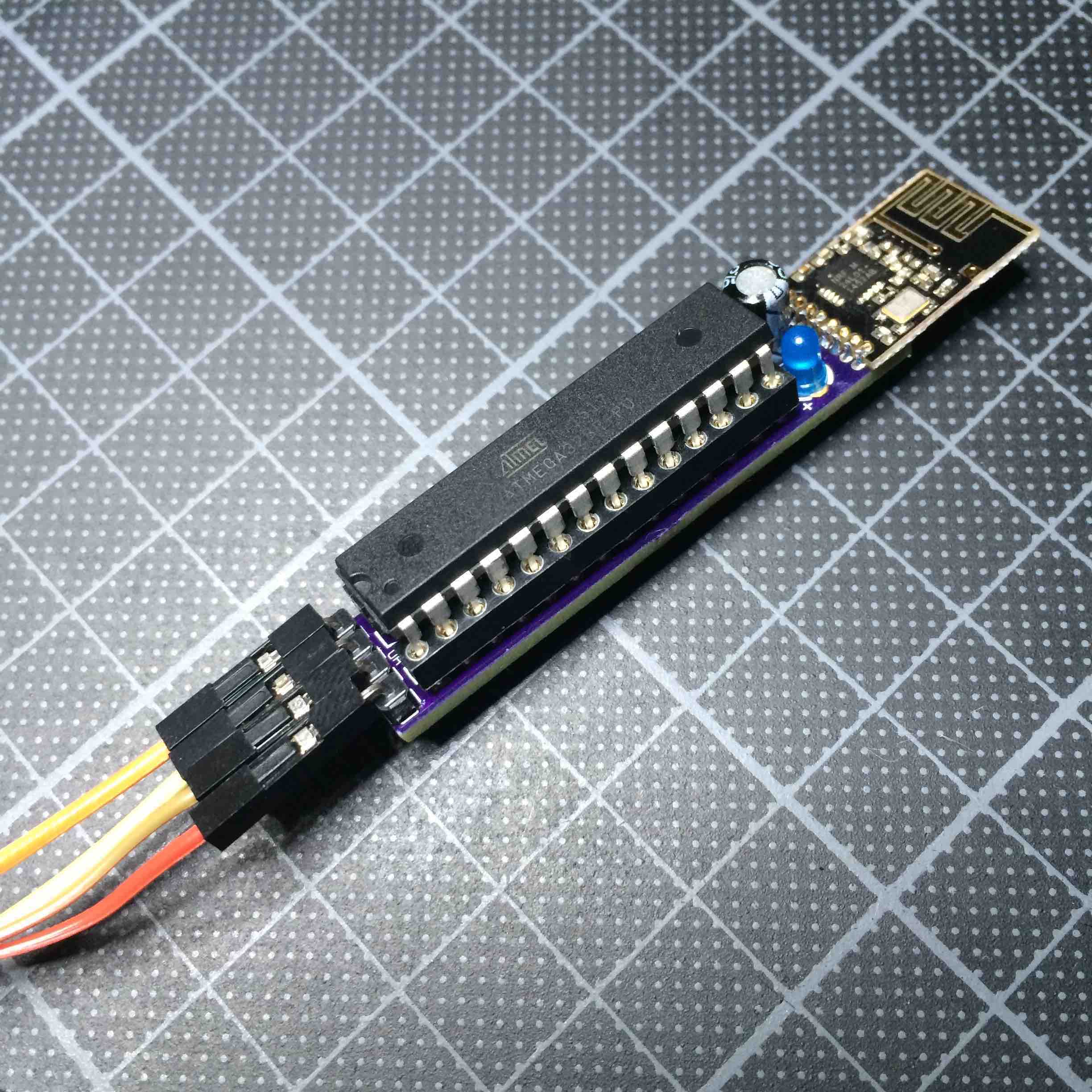💬 Very narrow and minimal switch node
-
@Carl H If the 1/4w resistor can fit in pads 7mm apart from each other, then should be no problem. But they need to stay flat to fit under the processor.
-
Hello, @GertSanders I would like to ask. How I understand it is possible to load different sketch type to this board and then I could use it like one of MySensors sketches? For example could I load MyS humidity sketch? Thanks!
-
Hello, @GertSanders I would like to ask. How I understand it is possible to load different sketch type to this board and then I could use it like one of MySensors sketches? For example could I load MyS humidity sketch? Thanks!
@jacikaas: to program the processor, you need to remove it from the board and program it on a breadboard or another board with ftdi interface.
But you can load a sketch like the humidity sensor sketch if you add a I2C sensor like a SI7021. I plan to do just that. -
The very narrow boards v1-1 have arrived :-)


-
The latest member of my growing sensor family, a reedswitch sensor with wakeup from power down by change on pin 2, wakeup every 23 hours to report battery voltage, and of course a blinky light when these things happen :-)



Just tested and found to be OK. Next board will be set up for using a I2C module (will be my smallest temperature sensor yet). Time for a glas of WestVleeteren and rest.
-
The latest member of my growing sensor family, a reedswitch sensor with wakeup from power down by change on pin 2, wakeup every 23 hours to report battery voltage, and of course a blinky light when these things happen :-)



Just tested and found to be OK. Next board will be set up for using a I2C module (will be my smallest temperature sensor yet). Time for a glas of WestVleeteren and rest.
@GertSanders said:
Just tested and found to be OK. Next board will be set up for using a I2C module (will be my smallest temperature sensor yet). Time for a glas of WestVleeteren and rest.
@GertSanders
Westvleteren Blonde is very nice :)
Can you please remind me the difference berwrrn v1 and 1-1?
I think it would be good to add FTDI connection, but the space is very limited -
@GertSanders said:
Just tested and found to be OK. Next board will be set up for using a I2C module (will be my smallest temperature sensor yet). Time for a glas of WestVleeteren and rest.
@GertSanders
Westvleteren Blonde is very nice :)
Can you please remind me the difference berwrrn v1 and 1-1?
I think it would be good to add FTDI connection, but the space is very limited@alexsh1 FTDI would be nice to reprogram more easily, but in my case I have a stable sketch which is loaded 1 time, and then the node is deployed. No point in providing extra pins or using boardspace if it is only used once or twice.
I saw that @AWI mentioned pogo-pins to make connections. Also a nice idea. In any case, my node is not designed to be flexible, and after programming I want to forget it. These nodes are sitting on doors and windows and need to do 1 thing only: show status of the reed-switched that are connected to them.
But adding some pads so that pogo pins can make contact to RX, TX and !RESET would still be possible.
It will be nice to see if a RFM69 radio can be connected by @carlierd . Looking forward to some pictures :-)
-
@GertSanders said:
Just tested and found to be OK. Next board will be set up for using a I2C module (will be my smallest temperature sensor yet). Time for a glas of WestVleeteren and rest.
@GertSanders
Westvleteren Blonde is very nice :)
Can you please remind me the difference berwrrn v1 and 1-1?
I think it would be good to add FTDI connection, but the space is very limitedThe difference between v1-0 and V1-1:
V1-0:
has 4 pins connected to VCC, GND, D2, D3 (in this sequence).
LED is connected to D8V1-1:
has 4 pins, of which 2 are fixed. Vcc and GND are at the outside (closest to board edge).
The two pins in the middle (pin1 and pin2) can be connected to two different pins each by using the solder jumper.
pin1 can be connected to SDA/A4 or to D2
pin2 can be connected to SCL/A5 or to GND
LED is connected to D6 -
@alexsh1 FTDI would be nice to reprogram more easily, but in my case I have a stable sketch which is loaded 1 time, and then the node is deployed. No point in providing extra pins or using boardspace if it is only used once or twice.
I saw that @AWI mentioned pogo-pins to make connections. Also a nice idea. In any case, my node is not designed to be flexible, and after programming I want to forget it. These nodes are sitting on doors and windows and need to do 1 thing only: show status of the reed-switched that are connected to them.
But adding some pads so that pogo pins can make contact to RX, TX and !RESET would still be possible.
It will be nice to see if a RFM69 radio can be connected by @carlierd . Looking forward to some pictures :-)
@GertSanders A bit off a hassle, but I don't need pads... ;-)
-
@GertSanders A bit off a hassle, but I don't need pads... ;-)
@AWI very nice, where did you buy the pins ?
-
@AWI very nice, where did you buy the pins ?
@GertSanders I used these pins. These work for me but there are many other types in the same store which could serve your needs better.
-
@GertSanders - my idea to use exactly for windows. I was thinking about z-wave ones, but £32 a pot is just way too expensive given I need quite a few. How do you power them?
-
@GertSanders - my idea to use exactly for windows. I was thinking about z-wave ones, but £32 a pot is just way too expensive given I need quite a few. How do you power them?
-
Dear
I ordered a few...:-)
Do you have a working sketch that is using less power?
Perhaps wit a motionsensor and a DHt ore something
I hope i get you hardware working..@Dombo71 said:
Dear
I ordered a few...:-)
Do you have a working sketch that is using less power?
Perhaps wit a motionsensor and a DHt ore something
I hope i get you hardware working..@Dombo71
You can find a few working sketches in the 'Build' section of the website. However, don't you have an idea what it is exactly you'd like to build? I would be useful to know before throwing any sketch.FYG DHT is by far not a favourite one for a battery use in my view. There are others - SI7120 or BME280
-
Dear
I ordered a few...:-)
Do you have a working sketch that is using less power?
Perhaps wit a motionsensor and a DHt ore something
I hope i get you hardware working..@Dombo71
What do you mean with "using less power"? -
Dear
I ordered a few...:-)
Do you have a working sketch that is using less power?
Perhaps wit a motionsensor and a DHt ore something
I hope i get you hardware working..@Dombo71
Motion sensors are also not so low power and as mentioned before, DHT are power hungry. SI7021 is much better for low power/low voltage use. -
@Dombo71
What do you mean with "using less power"?@GertSanders said:
SI7021
I hope i can make a 3 in 1 sensor
Motion / contact.
temp and humanity
Better should be a multisensor, with a lot of option so we can choose .
The examples on my sensor are most 1 sensor...And then work on a battery[s] for a year
Thanks for the SI7021 tip..
-
@GertSanders said:
SI7021
I hope i can make a 3 in 1 sensor
Motion / contact.
temp and humanity
Better should be a multisensor, with a lot of option so we can choose .
The examples on my sensor are most 1 sensor...And then work on a battery[s] for a year
Thanks for the SI7021 tip..
This board is not meant for more then 1 function.
